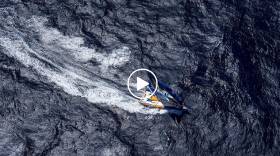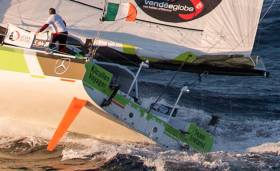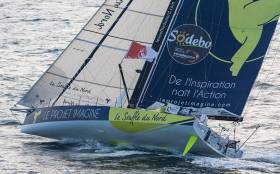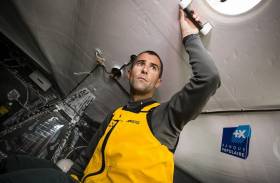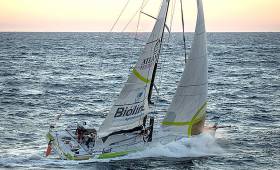Displaying items by tag: Vendee Globe
Vendee Globe Yacht Dismasted 770 Miles off Australia
At 1742 UTC on Saturday 17th December, Stéphane Le Diraison informed the Vendée Globe Race Directors that his Imoca Compagnie du Lit / Ville de Boulogne-Billancourt had dismasted.
The skipper was not injured and sounded in good health on the phone, when he called. He is currently in the process of sorting out the rig and will then carry out a complete check-up on his boat.
He was sailing in a 30-35 knot NW'ly wind, when the incident happened and is currently located 770 miles from the coast of Australia.
All of the project's sponsors are relieved that Stéphane is fine and remain 'in awe' of his performance during the race, during which he showed rigour and determination.
More news to follow.
Vendee Globe Sailors Pass Through Bass Strait To Avoid Storm
For the first time ever in the non-stop solo round the world Vendée Globe race's history, a competitor has gone through Bass Strait to avoid a storm in the Southern Ocean.
Frenchman Jean Pierre Dick (St Michel-Virbac) is the first Vendée Globe skipper ever to race through the Bass Strait. He was 45 nautical miles north of Devonport - half way across the north coast of Tasmania at 0400hrs TU this Wednesday. Dick was making 16kts and exited the Strait, and the shelter of Tasmania, at 0900hrs TU.
The French skipper has elected to sail a course over 400 miles north of the rhumb line, usual track, as he seeks to avoid a violent storm which is now passing to the south of him. A helicopter flew over Dick, a solo skipper who is lying in seventh place on his fourth successive Vendée Globe and has twice won the two handed Barcelona World Race around the world, in his first sight of other human life since he left Les Sables d'Olonne (France) on Sunday 6th November.
Quotes from the skipper:
“It's quite emotional going through the Bass Strait. It's very impressive with the wind getting up to 40 knots. I'm now going down towards New Zealand to get back into the Southern Ocean. You only get this sort of excitement in the Vendée Globe. I saw the coast of Tasmania and Clarke Island, which looked amazing. There are a lot of wind turbines, which proves that there is a lot of wind here. It's always strange getting back to civilisation, seeing earth and saying that we were in the Roaring Forties just a few days ago. Suddenly you are back in civilisation and it's a bit of a shock.”
Enda O'Coineen Climbs On to the Rudder to Free Jammed Lines
Ireland's first Vendee Globe competitor Enda O'Coineen climbed out over the stern of his round–the–world yacht to free a loose line. In 15th place overall from a fleet of 29, the Royal Irish Yacht Club sailor describes the latest obstacle to overcome on Kilcullen Voyager currently 600–miles east of the Kerguelen Islands, in the Southern Indian Ocean.
'This is hard. So that I can never, ever do something like this again, I will sign a legal binding document and give it to somebody in trust so that they can stop me from ever, ever, ever again doing something like this. It is tough, it is cold, it is wet and to think I did it with my own 'free-will' to live on the edge with constant challenges. The mind boggles, 'tis bonkers.
That said, I am thrilled to have survived this far. It has been an extraordinary adventure and personal journey, psychologically and physically. To boot, a good way to get fit! I am lucky and honoured to fly the flag and be in a position to have a go. The race organisers do a brilliant job. Thanks Laura Jacques and team. It is just wonderful to be part of and feel the emotional support, passion, celebrating the environment, the ocean, man against the elements and all that.
From reports some other skippers seem to have it tougher. I feel for them and note Conrad Coleman - on 100% Naturally, who has been performing extraordinary feats. And taking a line Mich Desj', two-time winner of the Vendee Globe, who says that you need to be mentally prepared for one major problem per day.
In one such problem on board Kilcullen, a mirror would have been useful, one which is on the "we forgot list." A sheet was jammed around the rudder and I could not see how or why. It was dangerous on the rudder and would not come clear. It would have been handy to look around the edge to see the problem.
In the end, we did an Alex Thomson. Namely canted the keel the wrong way and hardened the sails for the boat to heel and go more upwind. This worked. She was remarkably steady going along at an angle of about 60 degrees.
Then I climbed out over the stern and stood on the aft ledge and the port rudder was clear out of the water which I was able to stand on. Later that day a starboard sheet caught itself around the hydrogenator. Not as extreme, but another problem to be solved.
And having set out just of get around, it's not in my nature not to race or compete and to be 15th is just grand. Mr Motivator. And its been brilliant racing working to stay ahead of the American Rich Wilson, Alan Roura from Switzerland and Eric Bellion of France.
When the wind goes lighter we close up - and I suffer not being able to fly my asymmetrical sails. At some stages, we have been extremely close - we chat by email. At one time, I had warm VHF conversations with Alan and the mutual respect and support for what each is going through is powerful.
Our next landmark are the Kerguelen Islands, about 600 miles East. I am contemplating whether to pull in there to sort out my halyard problems and climb the mast.
After that its Cape Leeuwin off Australia the 2nd of the big 3 and after that its Cape Horn. Like eating the proverbial elephant, each day a little bit at a time'.
Enda O'Coineen
Lat 44 54 South
Long 55 40 West
Enda O'Coineen is now four weeks ino the Vendee Globe Race and reports from the Indian Ocean.
“Welcome to the Indian Ocean. Wow! The first to greet us was Rich Wilson on Great American IV. We trailed him by over 300 miles and finally caught him on the transition. I was feeling slightly smug and lucky that I was not having problems that other boats seemed to be having.
The day started normal. The wind was increasing so I thought I would furl the Blast Reacher and sail with the main alone with one reef and perhaps try the second. Then all hell broke loose. In preparing the furl line for the J3 became undone and the sail opened out of control. Then the furling line on the blast reacher broke leaving me stuck with two headsails out of control in the now gale force winds. Sheets and sails flogged, all wrapped around each other in a mess, as the wind howled. Then there was an involuntary gibe. As the boom crossed it caught in the runner and the boat, with the keel the wrong way, went on its side. Eventually I got to the keel hydraulics and pulled it up the other way and released the runner in the chaos while bringing the new one on. Rather than crash gybe back and risk serious damage, I continued the wrong gybe and set out to sort out the mess below and on deck. Fortunately, after a few hours the wrong gybe, the wind moved around and it became the right gibe.
To complicate matters the radar dome, one third the way up the mast - for no apparent reason - came loose and crashed down pulling the wires out of the mast. Fortunately, we saved the unit, but I am not sure it will work again on this voyage and minus an important safety tool.”
Hull Damage Leads to Water Ingress On Vendee Globe's Souffle du Nord pour le Projet Imagine
Shortly before 0700 UTC this morning in the Vendee Globe Race, Thomas Ruyant - Le Souffle du Nord pour le Projet Imagine – informed his boat captain, Laurent Bourguès, that damage to the boat had led to an ingress of water.
While operating his port ballast tank system, the end of the snorkel tube, which allows him to fill the tank when the boat is at speed, broke off without causing any further damage to the hull. Thomas immediately saw that a lot of water was coming inside the boat. He quickly blocked the leak with bags and anything else he could find within reach.
He immediately gybed to move to the port tack to keep the hole out of the water. Thomas has already managed to dry out part of the boat and is dealing with the situation.
With the support of Laurent Bourguès, he is currently looking for the best way to stem the flow of water. He has the required equipment on board.
Le Souffle du Nord pour Le Projet Imagine is currently experiencing 30-40 knot winds and heavy seas (3-4 m high waves).
Rescue Underway for French Vendee Globe Skipper
French Vendee Globe skipper Kito de Pavant was enduring an anxious wait this afternoon aboard his Bastide Otio after he struck an object which destroyed his keel housing, ripped off his aft keel mountings and left the appendage supported only by the hydraulic keel ram.
De Pavant, from the Occitanie region in SW France is placed 10th in the Vendée Globe round the world race some 120 miles to the north of the Crozet Islands. He reported a significant ingress of water, flooding the engine compartment. Race Direction have been working closely with the MRCC authorities at Gris Nez to organise a rescue. The MRCC have been in contact with the Marion Dufresne, the 120m long research and supply vessel of the TAAF (Terres australes et antarctiques françaises) which supplies the remote French archipelagos of Crozet, the Kerguelen, Saint Paul and Amsterdam islands. The Marion Dufresne was reported to be around 110 nautical miles away and had an ETA in the area during the early part of this evening with a plan to evacuate the skipper by rigid inflatable boat when daylight occurs around 0200hrs UTC.
Alain Gautier, the Vendée Globe Safety Director, explained: “We're hoping they will arrive at around 1700 UTC, but by then it will be dark there, so iti is down to the commanding officer of the ship to decide what sort of operation to carry out. They are likely to want to wait until day breaks at around 0100 UTC to launch a RIB to recover Kito. It will all depend on the conditions. We can imagine that the Marion Dufresne will position herself windward of Kito to try to calm down the seas. But she's not that big a boat, so we don't know if that will be enough to ensure a safe operation. Sunrise is at around 0130 UTC, but they may wait a while for the weather to ease. Already the winds will not be as strong during the night. Our goal is to get Kito aboard the Marion Dufresne. It will be up to Kito's team to deal with the boat, but that's not going to be easy in that zone. Meanwhile he has called us when he finds the time. After the shock this morning and the obvious disappointment, we can see that he is more in control of the situation now.”
De Pavant, 55 years old had battled through more than 48 hours of strong winds and big seas and was racing with a double reefed main making around 16kts in 40kts of wind and 4-6m seas. The popular skipper has been forced to retire from two previous Vendée Globe races, in 2008-9 when he was dismasted 18 hours after the start and in 2012-13 when he retired into Cascais after a collision with a trawler. In the previous editions, de Pavant's target was to win the Vendée Globe or at least to finish on the podium but prior to the start of this race he had stated several times that his primary objective this time was to achieve a finish. He had been sailing a mature, solid race since the start, taking no risks. “He had been sailing intelligently so far and this was his third Vendée Globe, so he really deserved a finish,” a shocked Yann Eliès told the Vendée LIVE programme when the news was broken live to the French skipper, who is in sixth place, and who himself had to be helicopter rescued after sustaining a fractured leg in December 2008 when south of Australia.
Sébastien Josse has been making steady progress in third place, back in race mode after a difficult 24 hours since he sustained damage to the port foil of his Edmond de Rothschild. Josse is reported to have secured the foil in its housing and was sailing at 10-13kts during this afternoon heading northwards. Critically Josse did not have to enter the Antarctic Exclusion Zone to escape the worst of the low pressure system, and by this afternoon the winds and seas had abated to more manageable proportions.
The group of four which are chasing behind the podium skippers, Paul Meilhat (SMA), Jéremie Beyou (Maitre CoQ), Yann Eliès (Quéguiner-Leucemie Espoir) and Jean Pierre Dick (StMichel Virbac) have made the best of the strong winds. Dick, in seventh, has closed to less than 170 miles behind Eliès and made more than 200 miles back on the leaders. Eliès is cutting back miles on Beyou and rookie Meilhat continues to sail a race which belies his relative inexperience in the Southern Ocean and is less than a day behind Josse now.
After 30 days of racing leader Armel Le Cléach (Banque Populaire VIII) has somewhere around 500 miles – or less than one and a half days of racing – to reach the half way point of the theoretical course distance of 24,500 miles. He leads Alex Thomson (Hugo Boss) by 90 miles this evening.
At 0930 UTC this morning (Monday), while he was sailing 600 miles west of the longitude of Cape Leeuwin, Sébastien Josse contacted his shore team in the Vendee Globe Race to inform them that he had suffered major damage to the port foil on Edmond de Rothschild. Taking into account the weather conditions the skipper of Gitana Team has had over the past 24 hours and the worsening weather that is forecast in the area in the coming hours, the skipper in agreement with the team's owners, has temporarily put the race to one side and is currently studying the best possible options to allow the worst of the storm to go by.
Since yesterday, Sébastien Josse has had to face some very rough conditions ahead of a tropical low coming down from Madagascar. This morning, while sailing on the port tack in a westerly air stream blowing at between 30 and 35 knots and on heavy seas with waves in excess of 4m, the 60-foot monohull, Edmond de Rothschild got swept along on a wave and then ploughed into the bottom. The boat came to a sudden standstill and in the incident the port foil suddenly went right down. It slammed into the top of the housing, which damaged the upper part of the appendage and its trimming system. Sébastien Josse was inside when the incident occurred and was not injured.
In order to make safe the foil, which threatened to come out of its housing, which could have had serious consequences for the structural integrity of the hull in this part of the boat, Sébastien Josse gybed to change tack and continue on his starboard foil while trying to carry out temporary repairs. Gitana 16 was on a N-NE'ly heading towards Australia, but for safety reasons was unable to continue on this course for very long. This is in fact the precise trajectory taken by the centre of the low pressure system that the sailor has been trying to avoid for the past 24 hours by making headway towards the east as quickly as possible along the Antarctic Exclusion Zone. According to the latest forecasts, the sailor was likely to be facing 50-knot winds and very heavy seas with 10 m high waves. Since 1300 UTC the 60-foot monohullEdmond de Rothschild has gone back to a SE'ly heading.
Cyril Dardashti, Director of Gitana Team, and all his team, are in constant contact with Sébastien Josse to find the best possible solutions as quickly as possible and put them in place.
Leeuwin Record on the Cards for Le Cleac'h in Vendee Globe Race
Armel Le Cleac'h should today smash the Vendee Globe Race record for the passage from Les Sables d'Olonne to Cape Leeuwin by somewhere around five and a half days. After adding to his lead over Alex Thomson last night, extending out to over 100 miles during a period of dificult, lighter breezes and awkward seas, the skipper of Banque Populaire VIII was 52 miles from the longitude of the second of the non stop solo round the world race's great capes at 0630TU this morning. The mark set on 15th December 2012 by Francois Gabart is 34 days 10 hours 30 minutes.
The testing, unsettled breezes have been making it difficult to go faster for the leaders, Le Cleac'h and Briton Thomson on Hugo Boss. Since midday yesterday five more skippers have entered the Indian Ocean passing the longitude of the Cape of Good Hope and Agulhas: Nandor Fa (Spirit of Hungary), Stéphane Le Diraison (Compagnie du Lit-Boulogne Bilancourt), Arnaud Boissières (La Mie Câline), Fabrice Amedeo (Newrest-Matmut) and Conrad Colman (Foresight Natural Energy). This tightly grouped pack is to the south of the tip of Africa when the leading duo of the Vendee Globe are at the longitude of the south west of Australia. This morning the fastest skippers have been Jean-Pierre Dick (StMichel Virbac) and Jean Le Cam (Finistere Mer Vent) making over twenty knots a times. Others in the South Indian Ocean have been forced to reduce sail to deal with the heavy weather.
In third place this morning Sébastien Josse, six hundred miles behind his French compatriot Le Cléac'h said: "We're getting into the real business now with lows we haven't seen before, but this is the round the world race, the Vendée Globe!" The skipper of Edmond de Rothschild is the closest to a deep low and has been sailing in more than 40 knots of wind with a four metre swell. With the exception of the two tail-enders, practically the whole fleet is now into the low pressure train rhythm of the Southern Ocean, alternating lows and zones of high pressure with strong winds and then calms before another low pressure front catches them.
Correspondingly skippers have been moving been performance mode and protection mode in order to take care of the boat and the equipment. Jérémie Beyou now has his mainsail operational again after replacing the hook and track car at the top of his mainsail track on Maître CoQ. Paul Meilhat (SMA) prudently headed some way north to let the worst of the storm go by to his south. Yann Eliès (Quéguiner Leucémie Espoir) slowed down for the same reason.
At the start of this fifth week of racing it is the changing moods and challenges of the Roaring Forties which dictate strategy. François Gabart, the winner of the last edition of the Vendée Globe, said yesterday "In the lows, you stay inside your boat and you note down what is starting to suffer from wear and tear. In the transition zone, when it starts to calm slightly, you do your little DIY jobs and you get ready for the next big blow."
Thomson Closes in on First Place in The Vendée Globe Race (Video)
British Skipper, Alex Thomson, is on track to re-claim his lead in The Vendée Globe Race. Over the past 24 hours Thomson has gained 22.2nm cutting Armel Le Cléach’h’s lead on board Banque Populaire VIII from 29.9nm to 7.7nm.
For the vast duration of the race so far, Thomson had been leading the fleet; however a week ago he sustained damage to his yacht, HUGO BOSS, after a collision with an unidentified floating object whilst in the Southern Atlantic. This resulted in his starboard foil breaking off which robbed his IMOCA60 of its ability to foil on port tack.
Despite the damage Thomson was able to hold his lead for a while until the wind angles changed on day 21 and Banque Populaire VIII was able to take advantage of Thomson not being able to use his damaged starboard foil.
The leading pair have just passed north of the Kerguelen Islands, a remote archipelago of islands in the southern Indian Ocean, known as the desolate islands, and are on route to pass Australia on their way towards Cape Horn in South America.
“You certainly feel isolated here in The Southern Ocean” Said Thomson, the only Brit in the race. “You are miles away from land in one of the remotest locations on the planet. There is no one here to help or rescue you if something goes wrong and the only things around you are birds and albatrosses.
“It’s for this reason that you need to be careful in The Southern Ocean. You don’t want to push the boat too hard and break something. I’m currently ahead of the front sailing at 18-24 knots. I’m going to stay conservative and try to nip at Armels heals, If I can”
The Vendée Globe takes place every four years and has historically been dominated by the French. This year’s edition sees 29 IMOCA 60s compete in the race, including Thomson, the only British entrant.
The race is renowned for being one of the most gruelling sporting challenges in the world. Just 71 of the 138 starters since the race’s inception, back in 1989, have successfully completed the race, and three have lost their lives along the way.
Thomson is determined to be the first British skipper to win the race, which could take in the region of 80 days to complete.
Enda O'Coineen Opts for Western Option in Vendee Globe Route Challenge
In the Vendee Globe the Saint Helena High has returned to the fleet and Ireland's Enda O'Coineen is one skipper in the 29–boat fleet that has plotted to sail around the anti–cyclone.
While the first 10 skippers have good conditions in the South and can maintain high speeds, the others are having to face up to an extension of the Saint Helena High that will block their route tomorrow.
3 competitors have apparently chosen to bypass the anticyclone via the West (Roura, 0'Coineen and Heerema). They are sailing downwind and should not stall too much. The rest of the fleet clearly preferred a shorter route. They're sailing upwind in an easing breeze, which is getting lighter with a big swell. The conditions are not easy and it's unlikely to improve tomorrow with the wind getting even lighter.
Which is the best choice? A longer route with favorable winds or a more direct route with lighter headwinds? Answer within 48 or 72 hours, once the whole fleet hits the Roaring Forties.



























